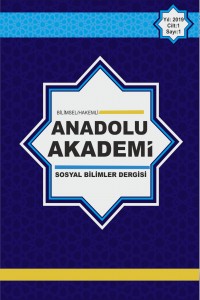Research Article
Year 2019,
Volume: 1 Issue: 1, 4 - 22, 12.01.2019
Abstract
Bu çalışmanın temel amacı örgütsel alanda
faaliyet gösteren çalışanların kişilik özelliklerinin (dışadönüklük, uyumluluk,
sorumluluk, deneyime açıklık ve nevrotiklik) bireylerin zihinsel, ruhsal,
fiziksel ve duygusal enerjileri üzerindeki etkisini incelemektir. Bu amaca
yönelik 410 mavi yakalı çalışan ile anket uygulaması gerçekleştirilmiştir.
Bulguların çoğu kurulan hipotezleri destekler nitelikte bulunmuş olup, kişilik
özelliklerinin zihinsel, ruhsal, fiziksel ve duygusal enerji düzeyleri üzerinde
anlamlı etkisinin olduğu tespit edilmiştir.
References
- Akdoğan, A. A., Arslan, A., & Demirtaş, Ö. (2016). A strategic influence of corporate social responsibility on meaningful work and organizational identification, via perceptions of ethical leadership. Procedia-Social and Behavioral Sciences, 235, 259-268. Akdoğan, A., & Demirtaş, Ö. (2014). Etik liderlik davranişlarinin etik iklim üzerindeki etkisi: örgütsel politik algilamalarin aracilik rolü. Journal of Economics and Administrative Sciences, 16(1), 103-120. Akdoğan, A., & Demirtaş, Ö. (2009). 360 Derece Performans Değerlendirme Sistemi: Askeri İmalat İşletmesinde Yöneticiler Üzerinde Bir Uygulama. Atatürk Üniversitesi İktisadi ve İdari Bilimler Dergisi, 23(1). Arthur, W., & Graziano, W. G. (1996). The five‐factor model, conscientiousness, and driving accident involvement. Journal of Personality, 64(3), 593-618.Bayram, A. (2016). Örgütlerde insan enerjisi: Öncüllerinin belirlenmesine yönelik bir araştırma. Doktora tezi, Erciyes ÜniversitesiBayram, A. (2017). Örgütlerde insan enerjisi: Teorik çerçeve. Hitit Üniversitesi Sosyal Bilimler Enstitüsü Dergisi, 10(2), 1021-1042.Burger, J. M. (2006). Kişilik (çev. İD Erguvan Sarıoğlu). İstanbul: Kaknüs Yayınları.Collins, R. (2004). Interaction Ritual Chains (Princeton Studies in Cultural Sociology). New Edition.Cross, R., Baker, W., & Parker, A. (2003). What creates energy in organizations?. MIT Sloan Management Review, 44(4), 51-57.Demirtaş, Ö., Karaca M. & Biçkes, D.M. (2017). Başarılı Girişimciliğin Perde Arkasındaki Güçler. Eğitim Yayınevi: KonyaDutton, J. E. (2003). Energize Your Workplace: How to Build and Sustain High-Quality Relationships at Work. Jossey-Bass, San Francisco,Goldberg, L. R. (1990). An alternative" description of personality": the big-five factor structure. Journal of personality and social psychology, 59(6), 1216. Gosling, S. D., Rentfrow, P. J., & Swann Jr, W. B. (2003). A very brief measure of the Big-Five personality domains. Journal of Research in personality, 37(6), 504-528.Hobfoll, S. E. (1989). Conservation of resources: A new attempt at conceptualizing stress. American psychologist, 44(3), 513.Hunter, J.P., & Csikszentmihalyi, M. (2003). The positive psychology of interested adolescents. Journal of youth and adolescence, 32(1), 27-35.Huselid, M. A. (1995). The impact of human resource management practices on turnover, productivity, and corporate financial performance. Academy of management journal, 38(3), 635-672.Loehr, J., & Schwartz, T. (2011). On form: Managing energy, not time, is the key to high performance, health and happiness. Nicholas Brealey Publishing.Luthans, F. (2010). Organizational Behavior 12 edition. McGraw-Hill Education.McCrae, R. R., & Costa, P. T. (1989). Reinterpreting the Myers‐Briggs type indicator from the perspective of the five‐factor model of personality. Journal of Personality, 57(1), 17-40. Özkalp, E., & Kırel, Ç. (2001). Örgütsel Davranış, Anadolu Üniversitesi Eğitim Sağlık ve Bilimsel Araştırma Çalışmaları Vakfı Yayınları Yayın No: 149.Pugh, S. D. (2001). Service with a smile: Emotional contagion in the service encounter. Academy of management journal, 44(5), 1018-1027.Quinn, R. W. and Dutton, J.E. (2005). Coordination as Energy in Conversation. Academy Of Management Review 30(1), 36-57.Random House Dictionary. Energy. (N.D.). Dictionary.Com Unabridged. From Dictionary.Com Website: http://dictionary.reference.com/Browse/EnergyRobbins, S. P., Judge, T., & Breward, K. (2003). Essentials of organizational behavior (Vol. 7). Upper Saddle River: Prentice Hall.Ryan, R. M., & Frederick, C. (1997). On energy, personality, and health: Subjective vitality as a dynamic reflection of well‐being. Journal of personality, 65(3), 529-565.Schaufeli, W. B., & Bakker, A. B. (2004). Job demands, job resources, and their relationship with burnout and engagement: A multi‐sample study. Journal of organizational Behavior, 25(3), 293-315.Scott, B. A., & Judge, T. A. (2006). Insomnia, emotions, and job satisfaction: A multilevel study. Journal of Management, 32(5), 622-645.Shirom, A. (2003). Feeling vigorous at work? The construct of vigor and the study of positive affect in organizations. In Emotional and physiological processes and positive intervention strategies (pp. 135-164). Emerald Group Publishing Limited.Smith, E. E., Nolen-Hoeksema, S., Fredrickson, B. L., Loftus, G. L., Bem, D. J., & Maren, S. (2003). Atkinson and Hilgard’s Introduction to Psychology, (Belmont, CA: Wadswoth/Thomson Learning).Somer, O., Korkmaz, M., & Tatar, A. (2011). Kurumdan uygulamaya 5 faktör kişilik modeli ve 5 faktör kişilik envanteri. İzmir: Ege Üniversitesi Yayınları.Suls, J., Green, P., & Hillis, S. (1998). Emotional reactivity to everyday problems, affective inertia, and neuroticism. Personality and Social Psychology Bulletin, 24(2), 127-136.Taylor, M. T. S., & Casey, A. (2011). Defining energy at work: How energy at work has been and may be defined. In 2011 AHRD International Research Conference in the Americas, Paper (Vol. 97, pp. 1-24).Thayer, R. E. (1990). The biopsychology of mood and arousal. Oxford University Press.Thomas, K. W. (2000). Intrinsic Motivation at Work: Building Energy and Commitment. Nertett, San Francisco.Vallerand, R. J., Blanchard, C., Mageau, G. A., Koestner, R., Ratelle, C., Léonard, M., ... & Marsolais, J. (2003). Les passions de l'ame: on obsessive and harmonious passion. Journal of personality and social psychology, 85(4), 756-769Yener, S., Arslan, A., & Demirtaş, Ö. (2015). Bilişsel farkındalık ile girişimci kişilik arasındaki ilişkide mizaç-karakter özelliklerinin aracı rolü. 3. Örgütsel Davranış Kongresi, Tokat
There are 1 citations in total.
Details
| Primary Language | Turkish |
|---|---|
| Journal Section | Articles |
| Authors | |
| Publication Date | January 12, 2019 |
| Published in Issue | Year 2019 Volume: 1 Issue: 1 |
Anatolian Academy Social Sciences Journal ISSN: 2667-5471

